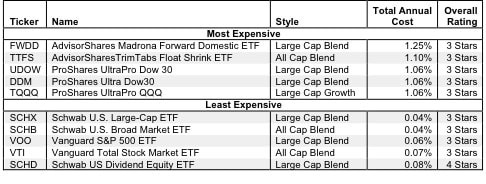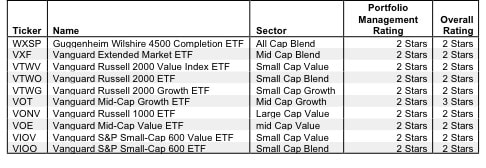Picking from the multitude of style ETFs is a daunting task. There are as many as 37 in any given style and at least 214 ETFs across all styles.
Why are there so many ETFs? The answer is: because ETF providers are making lots of money selling them. The number of ETFs has little to do with serving investors’ best interests. Below are three red flags investors can use to avoid the worst ETFs:
- Inadequate liquidity
- High fees
- Poor quality holdings
I address these red flags in order of difficulty. Advice on How to Find the Best Style ETFs is here.
How To Avoid ETFs with Inadequate Liquidity
This is the easiest issue to avoid and my advice is simple. Avoid all ETFs with less than $100 million in assets. Low levels of liquidity can lead to a discrepancy between the price of the ETF and the underlying value of the securities it holds. This makes it difficult to predict future performance.
How To Avoid High Fees
ETFs should be cheap, but not all of them are. The first step here is to measure what is cheap and expensive.
To ensure you are paying at or below average fees, invest only in ETFs with an expense ratio below 0.45%, which is the average total annual cost (TAC) of the 214 US equity style ETFs I cover. Weighting the (TAC) by assets under management, the average expense ratio is lower at 0.19%. The lower weighted-average TAC is a good sign that investors are putting money in the cheaper ETFs.
Figure 1 shows the most and least expensive style ETFs in the US equity universe based on total annual costs. ProShares provides three of the five most expensive style ETFs. ProShares provides all five of the most expensive sector ETFs. More on sector ETF costs is here.
Figure 1: Most & Least Expensive ETFs
AdvisorShares Madrona Forward Domestic ETF (FWDD) and AdvisorShares TrimTabs Float Shrink ETF (TTFS) are the two most expensive US equity style ETFs I cover. Schwab U.S. Large-Cap ETF (SCHX) is the least expensive. Vanguard Total Stock Market ETF (VTI) ranks well also and it has over $28 billion in assets. Schwab US Dividend Equity ETF (SCHD) is the top overall rated ETF in Figure 1 (i.e. the only ETF with a 4-star rating) in addition to being one of the least expensive.
Interestingly, ProShares UltraPro Dow30 (UDOW), ProShares Ultra Dow30 (DDM), ProShares UltraPro QQQ (TQQQ) are the next three highest overall rated ETFs in Figure 1 despite being among the most expensive ETFs.
These results underscroe why investors should not choose ETFs based only on price. The quality of holdings matters more than price.
How To Avoid ETFs with the Worst Holdings
This step is by far the hardest, but it is also the most important because an ETF’s performance is determined more by its holdings than its costs. Figure 2 shows the ETFs within each style with the worst holdings or portfolio management ratings. The ETFs are listed in descending order by style per my style ratings, detailed in my 1Q Style Rankings report.
Figure 2: Style ETFs With Worst Holdings (as of 3/25/13)
My overall ratings on ETFs are based primarily on my stock ratings of their holdings. My firm covers over 3000 stocks and is known for the due diligence done on each stock we cover.
Vanguard’s ETFs appear more often than any other provider in Figure 2, which means they offer the most ETFs with the worst holdings. Vanguard Russell 2000 Value Index ETF (VTWV) has the worst holdings of all small-cap value funds. Vanguard Russell 2000 ETF (VTWO), Vanguard Russell 2000 Growth ETF (VTWG), Vanguard Mid-Cap Growth ETF (VOT), Vanguard Mid-Cap Value ETF (VOE), Vanguard Russell 1000 ETF (VONV), and Vanguard Extended Market ETF (VXF) all have the worst holdings of ETFs in their respective styles.
Do Not Trust ETF Labels
Many ETFs are labeled “index” ETFs. Naturally, many investors might assume that having “index” in the ETF’s name means all the holdings are the same or the provider cannot influence the nature of the holdings, but that is not true.
For example, of the three “index” ETFs in the mid-cap growth style, two get a neutral rating while one gets a Dangerous rating. How is that possible if they are supposed to hold the same stocks? The answer is that they do not hold the same stocks.
There is no overlap in the top 5 holdings among these three ETFs. Their portfolios are not close to being the same. And there is a meaningful difference in the quality of holdings.
iShares S&P MidCap 400 Growth Index Fund (IJK) gets 2-stars or a Dangerous rating because it has more dangerous-rated holdings. iShares Morningstar Mid Growth Index Fund (JKH) and iShares Russell Midcap Growth Index (IWP) get 3-stars and have more neutral-rated holdings.
Hence, the “index” label, for mid-cap growth ETFs, is misleading as it does not mean that these ETFs have the same portfolio of holdings. For more on how the index label is misleading, see “Danger Zone 12/31/2012: iShares S&P MidCap 400 Growth Index Fund (IJK)”.
The point is that investors cannot trust the “index” label to mean that all the ETFs or mutual funds with that label hold a standard portfolio of stocks.
The Danger Within
Buying an ETF without analyzing its holdings is like buying a stock without analyzing its business and finances. As Barron’s says, investors should know the Danger Within. Put another way, research on ETF holdings is necessary due diligence because an ETF’s performance is only as good as its holdings’ performance.
PERFORMANCE OF ETF’s HOLDINGs = PERFORMANCE OF ETF
Note that no ETFs with a dangerous portfolio management rating earn an overall rating better than two stars. These scores are consistent with my belief that the quality of an ETF is more about its holdings than its costs. If the ETF’s holdings are dangerous, then the overall rating cannot be better than dangerous because one cannot expect the performance of the ETF to be any better than the performance of its holdings – no matter how cheap it may be.
Find the ETFs with the worst overall ratings on my ETF screener. More analysis of the Best Style ETFs is here.
Best & Worst Stocks In these ETFs
Delta Air Lines, Inc. (DAL) is one of my least favorite stocks held by VXF and earns my Dangerous rating. There is a lot to dislike about Delta, starting with the fact that it has earned negative economic earningsfor each of the past five years. Its return on invested capital (ROIC) of 6% puts it in the fourth quintile of all the companies I cover. A closer look at the company’s filings reveals more bad news. From DAL’s 2012 Form 10-K, the net funded status of DAL’s pension and retirement obligation is worse this year at -$15.9 billion than last year (-$14.1 billion). There is a substantial gap between funding and obligations, which puts the company at higher risk if the assets funding the pension plan fail to achieve DAL’s unusually high expectations. Click here for more details on DAL’s pension accounting manipulation.
Nevertheless, DAL is valued at ~$16.54/share. To justify this price, the company must grow after-tax profit (NOPAT) by 6% for the next 14 years. For a few companies, those profit growth expectations might be reasonable. However, airlines have a very poor history when it comes to profits. In fact, there is no history of profits. So, betting on any airline to achieve so much growth, especially in this economy, seems awfully risky.
Microsoft Corporation (MSFT) is one of my favorite stocks held by SCHD and earns my Very Attractive rating. While investors ooh and ahh over the new products put out by competitors like Apple (AAPL), Google (GOOG) and Amazon (AMZN), Microsoft has quietly raked in impressive profits. Yes, new gadgets are exciting, but MSFT’s 72% ROIC (top 10 in the S&P 500) and 12% NOPAT growth compounded annually over the past decade should excite investors more. The fact that the share price has barely risen over last ten years shows how undervalued MSFT is. The current share price of ~$28.18 gives MSFT aprice to economic book value ratio of 0.6, meaning the market is anticipating a permanent 40% decline in Microsoft’s NOPAT. Investors should not mistake a lack of hyped new products with a bad business. Microsoft is highly profitable and heavily undervalued, an ideal combination for investors. SCHD’s allocation to Microsoft and other Attractive-or-better rated stocks, combined with low fees, make it an Attractive-rated (4stars) ETF.
Sam McBride contributed to this report.
Disclosure: David Trainer owns MSFT. David Trainer and Sam McBride receive no compensation to write about any specific stock, sector, or theme.


